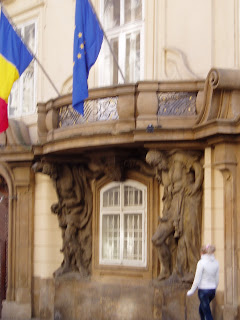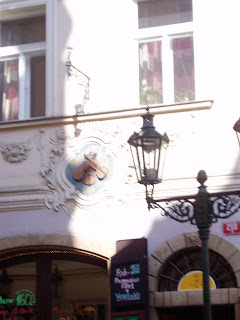March 21
Started the day off with breakfast at the hostel and had to figure out how to adjust the clock on my phone an hour to Prague time. Then we headed out early and took a tram and the the metro to the train station so that we could make reservations for the night trains were were planning on taking later. We had spent a good six or so (nonconsecutive) hours while at Sussex trying to make reservations before giving up and hoping we could just do it in Prague. As hoped for, all went smoothly. Then i was time for the real sightseeing: Prague Castle. On the way we went by the Church of St Nicholas and unfortunately didn't go in but the highlights of this church include an organ built in 1746 and played by Mozart in 1787. We also walked down Nerudova Street. This street is named for the writer Jan Neruda who lived here and wrote many short stories set in this area of Prague. The street is also know for the number of signs of heraldic beasts and emblems used to distinguish houses before numbers were introduced in 1770.
Prague Castle was a huge complex but here are some of the highlights.
St. Vitus's Cathedral: this was begun in 1344 and replaced a Romanesque basilica dating back to the time of St. Wenceslas (around 925). The Cathedral contains the Bohemian crown jewels, the tomb of Good King Wenceslas, and so cool and much more modern art art deco-y stained glass windows by Alfons Mucha. It was awesome.
outside the Castle:



Schwarzenberg Palace: The Palace was built in the 16th century and now houses Bohemian art from the Renaissance and Baroque periods.
St. George's Basilica: founded by Prince Vratislav, my guide book tells me it is the best preserved Romanesque church in Prague. attached is ST. George's convent, founded in 974 which now houses Czech art.and finally the Royal Palace itself: The palace was the seat of Bohemian Kings since the 11th century and consists of three architectural layers from the Romanesque palace that forms the basement to the Gothic Vladislav hall. Cool features include the Rider's Staircase just off of Vladislav Hall which has very low steps to enable horses go go up them. It was used by knights on horseback to get to jousting contests. I still don't fully understand why this was needed indoors. Later, under Hapsburg rule the palace housed government offices and the old Bohemian Parliament and of course was the sight of one of my favorite historical events, the defenestration of Prague in 1618. Defenestration, a really great word, means "the action of throwing out of a window"(http://dictionary.reference.com/browse/defenestration). In 1617, Catholic Bohemian officials were closing Protestant chapels and thus violating former guarantees of religious liberty. In response an assembly of Protestants was called in Prague and they found the Catholic imperial regents responsible for this violation. One thing led to another and the regents were throw out the third floor window (some sources say 70 meters) where they subsequently landed on a pile of manure and survived. The Catholics asserted that their survival was due to the mercy of angels. This whole event was involved in the start of the Thirty Years War in 1618. What's most disturbing now that I've refreshed my knowledge of this defenestration is that a number of defenestrations have occurred through the history of Prague although only one other in 1419 is also commonly referred to as the defenestration of Prague. Anyway, we did get to see but were not thrown out of the defenestration window.
After a morning at Prague Castle we walked down Charles Bridge. This bridge was commissioned in 1357 by Charles IV and is decorated with many statues the first of which was erected in 1683. A number of people were rubbing some of the bronze statues on the bridge. I still have no idea why.



Then it was on to Old Town Square where we ran into some kind of little fair and sampled some more Czech food. We also ran into a giant monument to the reformist Jan Hus who was burnt at the stake for heresy in 1415. But our main reason for going to the square was to see the astronomical clock on the Old Town Hall. The Old Town Hall tower dates from 1364 and the clock was built in 1490 (really old!). The clock records, Old Bohemian time, time as we know it and Babylonian time as well as showing the movements of the sun and moon through the zodiac. We waited around until the hour to see the mechanical figures preform and then someone on the top of the tower played a trumpet fanfare-thing.
Next, (it was very full day) we headed off to find the Lennon Wall. According to wikipedia,
"In 1988, the wall was a source of irritation for the communist regime of Gustav Husak. Young Czechs would write grievances on the wall and in a report of the time this led to a clash between hundreds of students and security police on the nearby Charles Bridge. The movement these students followed was described ironically as "Lennonism" and Czech authorities described these people variously as alcoholics, mentally deranged, sociopathic, and agents of Western capitalism."
The wall originally featured a portrait of John Lennon which has been painted over as the wall constantly changes from being painted. The Lennon was was petty coll and we rather unsuccessfully tried to add our own graffiti in blue pen (which was all we had with us). Needless to say I took a ton of pictures just trying to encompass some of what was on it.


Finally, it was time to call it a day. We headed back to the hostel and then ventured back out for a Czech Mex dinner (surprisingly good, real more central Mexican food. It was actually somewhat reminiscent of California Mex). We ended the night sampling a Czech beer at happy hour at the hostel. Because only one was cheaper that night we ended up all having Budvar before Rose said "wait is this just Budweiser?" So much for Czech beer. Or maybe not? While writing this blog I looked up Budweizer Budvar which my guidebook tells me is the Czech Republic's most exported beer, only to find that they are currently in a trademark dispute with Anheuser-Busch. So, maybe we were more successful in our quest for things Czech than we thought. Budvar and Czech Mex aside, it was a pretty packed and successful first full day of our trip.

















No comments:
Post a Comment